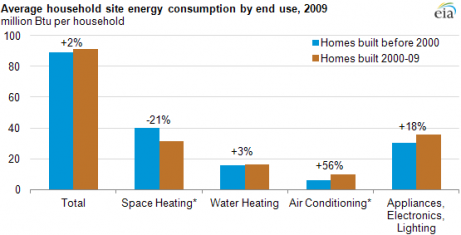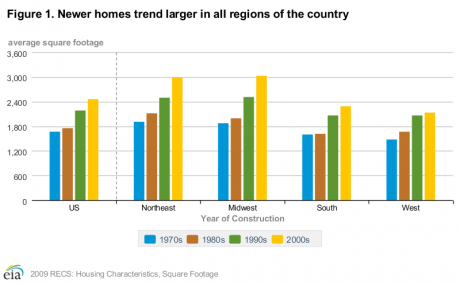Study Confirms that Big Houses Have Big Energy Needs
The recent Residential Energy Consumption Survey (RECS) by the Energy Information Administration (EIA) shows that homes have become slightly more efficient in the 2000s versus previous decades, but a 30% increase in home size has totally negated all of those gains. As the EIA reports:
As square footage increases, the burden on heating and cooling equipment rises, lighting requirements increase, and the likelihood that the household uses more than one refrigerator increases.
The average home of the 70s and the 80s was a mere 1800 sq ft, compared to 2200 of the 90s and 2465 of the 2000s. The increased area has brought along with it increased energy needs.
But that’s not all. Here are some other findings from RECS:
- Higher ceilings: “17% of homes built in the 1970s have higher than the traditional eight-foot ceilings, while that number increases to 52% in homes built in the 2000s.”
- Coldest regions have biggest homes. “In the Midwest, where space heating accounts for half of home energy consumption, residents heat more space on average than any other part of the country. In Wisconsin, for example, the average heated square footage is nearly 2,100 square feet. By contrast, homes tend to be smaller in parts of the country where space heating is less intense. In California, where most of the population resides in mild or hot climate regions, the average heated square footage is 1,180.”
- More A/C cooling bigger homes. “Central air-conditioning was installed in 85% of homes built in the last two decades, resulting in a dramatic increase in the amount of residential space that is cooled and contributing to a nearly two-fold increase in electricity consumed for air-conditioning.”
- Some gains. “While overall home size and air conditioned space have been increasing, the likelihood that a home will have key energy efficient features rises as its square footage increases. Residents in larger homes consider their homes to be better insulated than those in smaller homes and these homes tend to have more efficient windows.”
We don’t often talk a lot about the environmental implications of an edited life. We believe the benefits of living with less, but better is its own reward. But, obvious as it sounds, smaller homes are greener.
Granted, there might have been a significant reduction in efficiency in smaller homes in the 2000s, but we suspect that many of the efficiency measures applied to larger homes were also applied to small ones. We don’t think it’s too conjectural to say that if the homes of the 2000s hadn’t grown so much, the more efficient appliances and better insulation, now applied to huge houses with high ceilings, would be applied to more modest homes with modest energy footprints and cheaper operating costs.






